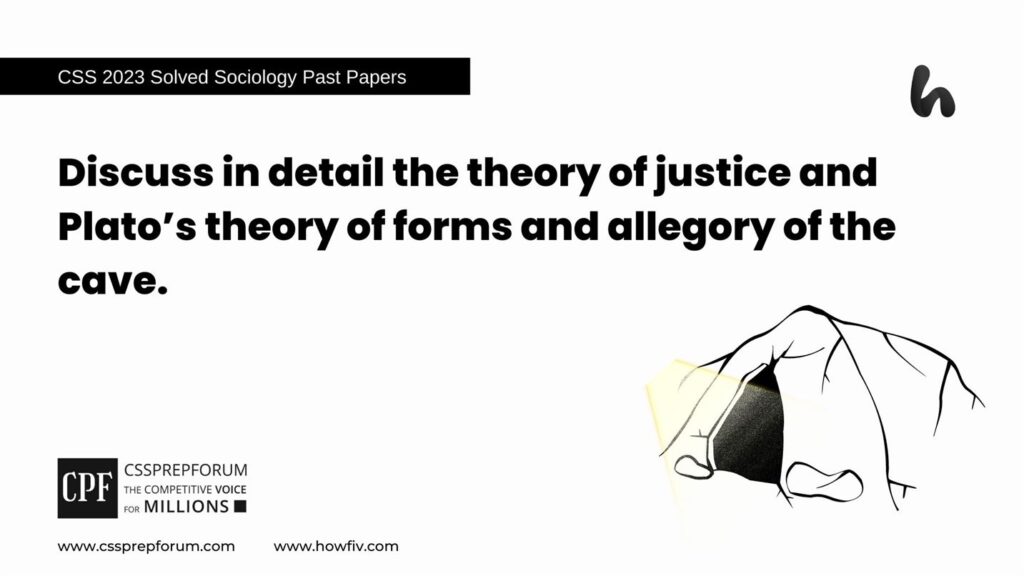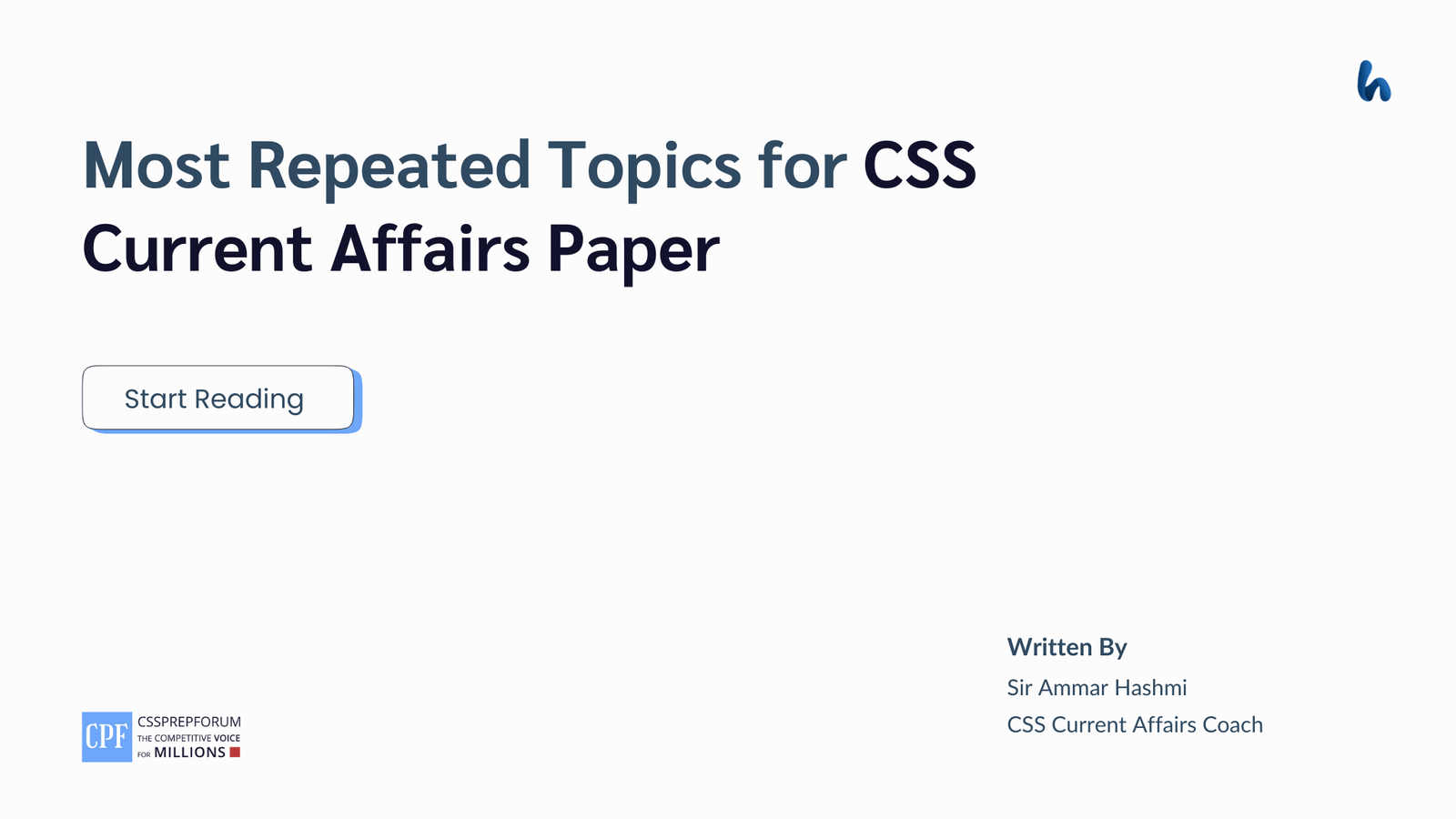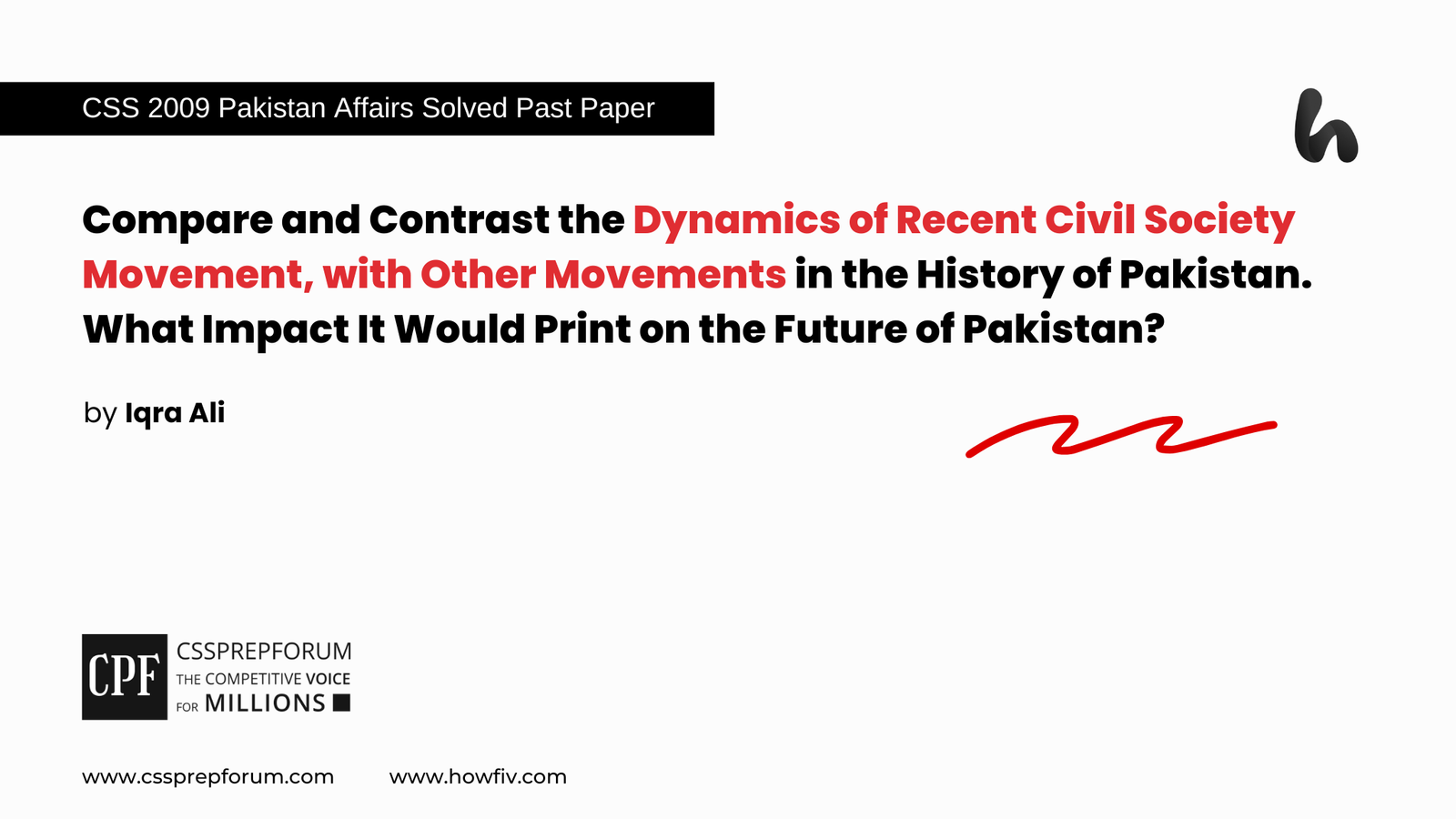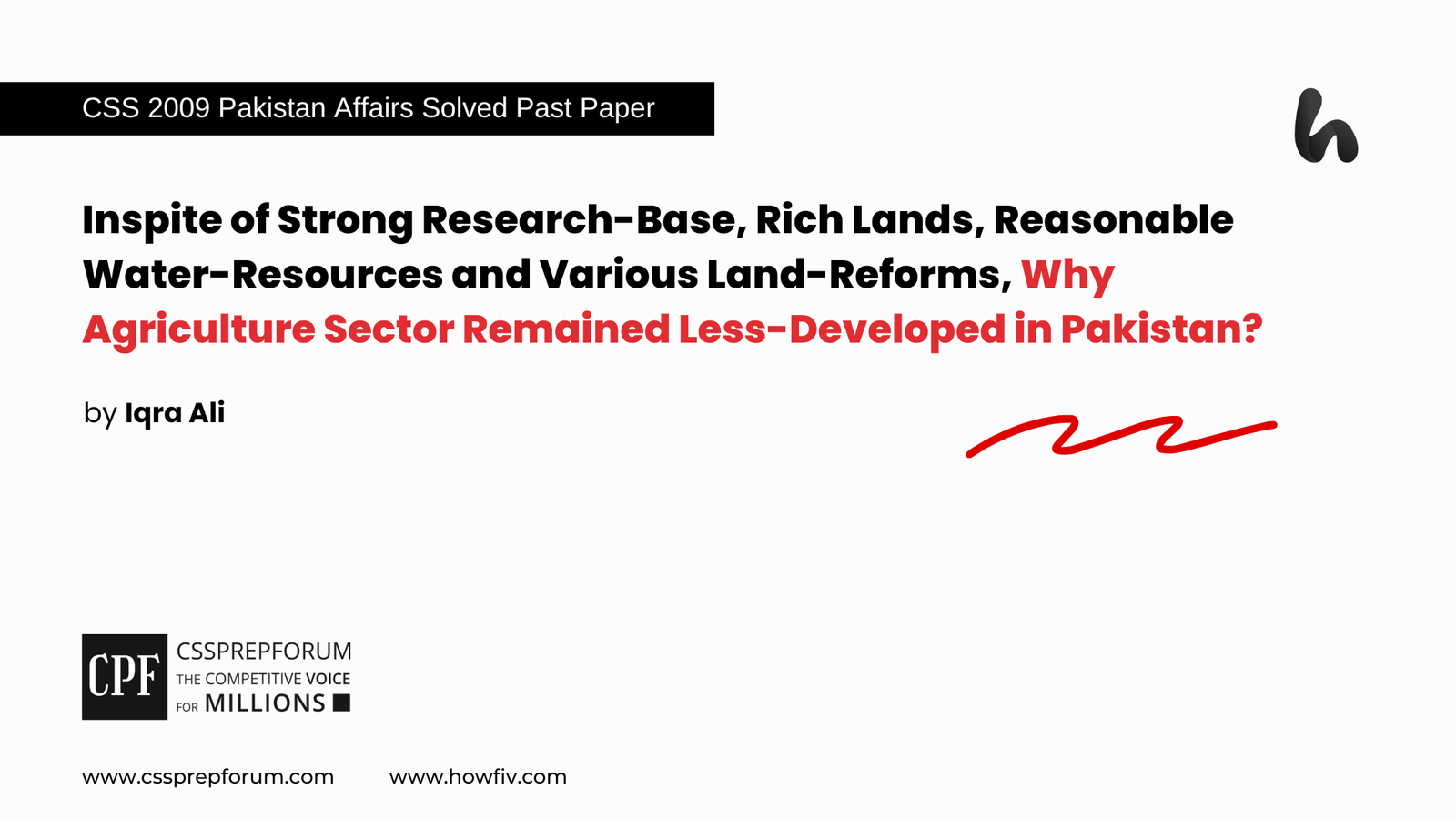CSS Solved Sociology Past Papers | Discuss in detail the theory of justice and Plato’s theory of forms and allegory of the cave.
The following question of Sociology is attempted on the same pattern, taught by Sir to his students, scoring the highest marks in compulsory subjects for years. This solved past paper question is uploaded to help aspirants understand how to crack a topic or question, how to write relevantly, what coherence is, and how to include and connect ideas, opinions, and suggestions to score the maximum.

Question breakdown
This question has two parts:
1-demands elaborate Plato’s theory of justice with its aspects
2. requires the description of the theory of forms with the sketch of the allegory of the cave as explained by Plato
Outline
1- Introduction
2- Plato’s Theory of Justice
- a-Individual justice
- b-political Justice
- c-education justice
3- Characteristics of Plato’s theory of justice
4- Plato’s Theory of forms
5- Allegory of cave
6- Synthesis
7- Conclusion

Answer to the question
Introduction:
Plato was a Greek philosopher who gave the concept of justice concerning politics, individuals and education with a comprehensive overview of Athenian society. This idea encompasses the concept of equality and justice as a code of conduct to establish a perfect society. He conceptualized a unique ideation about the forms where he explains things how he sees them. He was influenced by scepticism which was the legacy of his mentor Socrates. He reflected utopianism in his ideology. To understand the theory of forms, he presented the sketch of the allegory of the cave that describes the realms of the world and differentiates the real world and the spiritual world. Plato was averse to democracy on the accord of certain unpleasant incidents became pivotal for his conceptualization of justice and explanation of realms.
Background:
| Ideology | Rationalism and utopian |
| Focus | Justice & skepticism |
| Influenced | Augustine, Cicero, Hegel, Russel, Hobbes |
| Influenced by | Socrates, Holmes, Protagoras, Pythagoras, Hercules |
| Keywords | The Republic, the allegory of the cave, The apology, The laws, The politics |
Plato was born in 428 nearly in Athens when the Athenian democracy was already well developed. He belonged to a wealthy and aristocratic family. Plato’s family was involved in politics and he was no stranger to politics himself. He was also the founder of the first western world University and the first school of philosophy. Early adulthood coincided with the period of political dislocation following the defeat of Athens in the pelopessian war of 431-404 BC. The overthrow of the democratic constitution of Pericles and the establishment of a ruling council of the thirty oligarchs. He had seen his friend and mentor condemned to death under the ensuing democracy.
Plato’s Theory of justice:

Plato portrays the ideal state in his publication ‘Republic’ as the panacea for the crisis and to diagnose the repercussions of democracy. He presented the idea of philosopher kings and focused on rationalization. The ideal state reflects the utopian schema, but here Plato meant an ideal state as a milestone to decide what to do and what should be done to implement justice and equal distribution of resources. He associated the conceptualization of justice with ‘virtue’ to keep the moral check and balance.
- A- Individual justice:
It encapsulates:
- The rational part of reason seeks after truth and is responsible for our philosophical inclinations. It enables an individual’s abstract and moral reasoning. It directs the machination to conceptualize and build an opinion based on reasoning and logic. Intellectuals and philosophers depict this theme
- The spirited part reflects desires for glory and honor. It is also responsible for feelings of anger and indignation. Courage is the thematic essence of this part. The military represents this quality
- The appetitive part is responsible for primate and base desires such as the desire for acquisition of material goods, food and sexual desires. In the current scenario, it represents the lower middle class in Pakistan.
- B- Political justice:
It comprises the following
- Guardians or rulers: who ought to be dominated by and representative of reason and rational part
- Auxiliaries or warrior classes: who defend the country are dominated byand representative of the spirited part
- Producers: responsible for their appetitive instincts consisting of craftsman, farmers, and artisans constitutes the lowest ring of the social ladder.
- C- Educational justice:
- Education aims to develop character and train the mind. Plato optimized the education institution to establish the rule of philosophy. Additionally, platonic education was directive to adjust the curriculum of education to the stage of intellect growth of the pupil.
- The system of education is divided into two parts:
- Elementary education: begins at three and ends at twenty. It is divided into three stages. The first stage extends from the age of three to six. the second stage imparts education to the age group from seven to eighteen and it comprises moral religious truths, music, poetry, and mathematics. The third stage encapsulates the age group from eighteen to twenty and imparts gymnastic training.
- Higher education: starts at age of twenty. here intellectuals are selected as philosopher kings. Those who failed were to become low-rank soldiers and warriors then the less distinguished position holders enter the administrative services. at the age of thirty-five, those who complete their advanced education are assigned civil and military administration positions for fifteen years as an apprenticeship. At the age of 50 pupils with real ability and served with genuine distinction become the ruling guardian from here emerges the philosopher king.
Characteristics of Plato’s theory of justice:
The characteristics of the ideal state depict the theory of justice vividly:
1- Division of labour:
Plato necessitated cooperation for sound social interaction and to practice virtue like empathy. This would be beneficial for stringent social networks and, ultimately, social integration. Otherwise, humans will be unable be meet their daily needs and cannot survive alone
2- Functional specialization:
Depending on the quality and virtue, one has to play its role in society to run the whole social systemization. Plato defined the functional specialization criteria as wisdom, courage and appetite. He elaborates that social functions should be assigned to relevant persons as per their qualifications and not to everyone. For this reason, he prefers philosopher kings to run the state business.
3- Geographical proximity and population:
Plato idealized a low population of 5040 people for geographical proximity for better social functioning and to maintain justice. He advocated that classes must be confined to their specific functions to avoid selfishness and interference because if the people mind their business and do not meddle with the affairs of others, justice in the state will prevail.
4- Equal education for men and women :
Plato considered men and women equal roles in society. He gave his viewpoint that women should not be confined to household and childbearing but should play an equal role and participate in society. He advocated equal education for men and women as per the class criteria.
5- Communism of wives and children:
Plato advised the philosopher kings to avoid the family bond and treat women and children as a commodity. According to his viewpoint, selective women with specific qualities should be married by philosopher kings to breed a productive generation with desired qualities to produce intellectuals.
6- Philosopher king:
Further, on the accord rationalization of Plato, the philosopher king is ideal to run the state business. No other individual is a suitable choice for rationalization. this illustrates the regulation by virtue, rule of philosophy and idealism to drive justice in society.
Plato’s theory of forms:
In this theory, Plato exclaims that the physical world is not the real world, instead, ultimate reality exists beyond our physical world. This idea was based on skepticism which is inherited from Socrates as mentioned in ‘Republic’. There are two realms:
1-Pysical realm: the material stuff we see and interact with daily. It is the shadow of true reality
2-Spiritual realm: also called the realm of forms, a realm of ideas or the realm of ideals
What is meant by ideal? Here Plato’s ideal means perfect in sense of criteria, standards or code of conduct that is set to attain the milestone. The utopian angle of the theory of forms enunciates what to do and what should be done.
For example,
- the ideal form of friendship is to be kind and empathetic
- The ideal form of education is productive and purposive education
Plato’s ideal is the result of deep understanding and careful engagement with reality. For instance, making a security-based airport an effective and optimal system is the ideal form. In this scenario, Plato’s ideal acts as a guide to focus where one is trying to head amidst a rough and tumble material world teemed with challenges and opportunities
What are forms?
Form connotes the abstract, perfect, unchanging concepts or ideals that transcend time and space. Its focus is on the ideal version i.e. utopian and is the ideal forum for anything. It is a blueprint or a set of instructions for making a very good version of something which prevents distractions and prepares an individual for decision-making and problem-solving by keeping in mind what to do, what should be done, and what has to be done.
Allegory of the cave:
Plato uses the cave as a symbolic representation of how human beings live in the world, contrasting reality with our interpretation of it. These two ideas reflect the two worlds in the story: the world inside the cave, and the world outside. The main idea of this allegory is the difference between people who simply experience their sensory experiences, and call that knowledge, and those who understand real knowledge by seeing the truth. The allegory contains some movements: the enchainment to the shadows, the releasement from the chains, the passage out of the cave and into the light of the sun, and the return back from the light of the sun into the cave. Plato’s cave tells us about what we see with our eyes and that what is in front of us is an illusion.
A- Physical realm in the context of the allegory of the cave:
- The cave: Plato illustrates a cave in which there are three prisoners. They are tied to some rocks in such a way that their bodies are bound, and their heads can only look at the stone wall in front of them. They were in this position since their birth and have never seen what lies outside the cave. Behind them is a fire, and between them is a raised walk. People outside the cave walk on this walkway carrying different things on their heads, which include: plants, wood, artefacts and animals etc.
- The shadows: Since these prisoners have only ever seen the shadow of those objects, they have come to be that these shadows are the real object in the world.
- The escape: One of the prisoners escapes the bondage and escapes the cave. He is surprised as he discovers that he has been living under illusion his whole life when he looks at actual objects. Gradually, he realizes that his previous view of reality was wrong as he grasped the true nature of reality
- The return: He then comes back to the cave and informs the other prisoners but they don’t believe in him and threaten to kill him if he attempts to set them free.
B- Spiritual realm in the context of the allegory of the cave:
- The cave:
The cave in Plato’s story represents the conventional view that true knowledge comes from our senses, i.e. empiricism, which Plato vehemently opposes and points out that most people, prisoners, have never experienced the true nature of reality because they relied on their sensory factuality. - The shadows:
Shadows represent the perceptions of those who rely exclusively on what they see and hear, instead of their rational faculties to grasp reality; such people according to Plato only witness a shadow of truth and not the complete truth. - The escape:
The escaped prisoners represent the philosophers who have broken free from the bondage of sensory apparatus and attempt to grasp the full nature of truth and knowledge using their mental and rational faculties. - The return: Ordinary people do not see reality the way philosophers do. Hence, they make wrong choices and are not fit to rule. Only the philosopher has the skill and wisdom to rule an ideal society.
Synthesis:
Plato was a well-known Greek philosopher for his conceptualization of the ideal state, where he ensures the demonstration of justice and equality. He gave a utopian ideology to practice rationalism and the rule of philosophy. To regulate the whole machinery of an ideal state, Plato induced the ideation of virtue, i.e. morality, to attain perfection via social solidarity. Similarly, the theory of forms demonstrates the physical realm and spiritual realm and provides guidance to choose the focused and right option among the distractive opportunities. Allegory of the cave illustrates the illusional mindset and the knowledgeable mind, which signifies the importance of the philosopher king. Very least, we would all behave a lot more sensibly. ‘This is how I see it,’ Socrates says in the Republic: In the knowable realm, the form of the good is the last thing to be seen, and it is reached only with difficulty. Once one has seen it, however, one must conclude that it is the cause of all that is correct and beautiful in anything, that it produces both light and its source in the visible realm, and that in the intelligible realm, it controls and provides truth and understanding, so that anyone who is to act sensibly in private or public must see it. On that wise, both theoretical perceptions coincide at the point of virtue, rationality, specialized division and rule of philosophy.
Conclusion:
The extract of the subject is that three virtues define the ideal state of Plato based on justice articulates the rational part, the spirited part and the appetitive part that defines individual justice, political justice and educational justice. Similarly, the allegory of the cave unleashes the in-depth meaning of the perfect outlook of Plato. It represents the two realms of illusion and reality perception. In this manner, Plato gives the utopian strategy of the philosopher king as the best choice to cultivate justice.
CSS Solved Past Papers’ Essays
Looking for the last ten years of CSS and PMS Solved Essays and want to know how Sir Kazim’s students write and score the highest marks in the essays’ papers? Then, click on the CSS Solved Essays to start reading them.
CSS Solved Essays

CSS Solved General Science & Ability Past Papers
Want to read the last ten years’ General Science & Ability Solved Past Papers to learn how to attempt them and to score high? Let’s click on the link below to read them all freely. All past papers have been solved by Miss Iqra Ali & Dr Nishat Baloch, Pakistan’s top CSS GSA coach having the highest score of their students.
General Science & Ability Solved Past Papers
CSS Solved Pakistan Affairs Past Papers
Want to read CSS Pakistan Affairs Solved Past Papers and learn how to attempt them to score high? Let’s click on the link below to read them all freely. All past papers’ questions have been attempted by Sir Kazim’s students, who scored the highest in the subject.
CSS Solved Pakistan Affairs
CSS Solved International Relations’ Past Papers
Have you opted for International Relations in the CSS examination and want to score above 150? Then, click on the CSS Solved International Relations’ Past Papers by Miss Abeera Fatima, the top IR scorer and the best IR coach in Pakistan.
CSS Solved International Relations Past Papers
Articles Might Interest You!
The following are some of the most important articles for CSS and PMS aspirants. Click on any to start reading.












